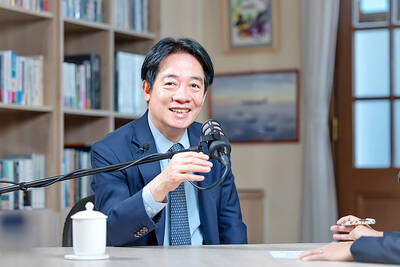Japan’s Sony Corp yesterday announced smaller-than-expected first quarter losses, helped by cost cuts, but kept its forecast for a second straight year in the red because of slumping sales.
Like other Japanese high-tech giants, Sony has been badly hurt by the global economic downturn, which has depressed demand for televisions and other electronic gadgets and pushed up the value of the yen.
Sony posted a net loss of ¥37.1 billion (US$390 million) for the fiscal first quarter through last month, reversing a year-earlier profit of ¥35.0 billion. Markets had expected a bigger loss of about ¥110 billion.
It logged an operating loss of ¥25.7 billion, against a year-earlier profit of ¥73.4 billion, as revenue slid 19.2 percent to ¥1.60 trillion.
The maker of Bravia televisions, PlayStation game consoles and Cyber-shot cameras maintained its forecast for its first back-to-back annual losses since it was listed on the stock market in 1958.
The company also announced that it had entered into a joint venture agreement with fellow high-tech giant Sharp Corp to produce and sell large liquid crystal display panels and modules.
Sony will invest ¥10 billion for a 34 percent stake in the venture, with Sharp taking majority ownership.
Sony, which announced in May its first annual loss in 14 years, expects to end the current business year ¥120 billion in the red. The company has had a difficult few years in the face of tough competition from rival products such as Apple’s iPod and Nintendo’s Wii.
Nintendo Co said yesterday its net profit plunged 60.6 percent in the quarter to last month from a year earlier to ¥42.32 billion (US$445 million) as sales of its Wii console dropped sharply.
The company sold 2.23 million Wii video game machines worldwide in the fiscal first quarter, down from 5.17 million a year earlier.
But the group expects its first drop in operating profit in four years, underlining the challenge it faces in maintaining its recent rapid growth.
Sharp said yesterday it booked a net loss of US$265 million in the three months to last month on lower sales and restructuring charges, but expected to return to profit for the full year.
The company reported a net loss of ¥25.2 billion for the quarter, reversing a year-earlier profit of ¥24.9 billion.
Revenue tumbled 20 percent to ¥598.3 billion, hit by lower sales of flat-panel TVs and cellphone handsets as well as sharp price drops in liquid-crystal displays (LCDs), a core product for the group.
Sharp maintained its outlook to return to profit on a full-year basis.
It expects a net profit of ¥3 billion and operating profit of ¥50 billion for the year to next March on revenue of ¥2.75 trillion, all unchanged from estimates it released in April.

Nvidia Corp yesterday unveiled its new high-speed interconnect technology, NVLink Fusion, with Taiwanese application-specific IC (ASIC) designers Alchip Technologies Ltd (世芯) and MediaTek Inc (聯發科) among the first to adopt the technology to help build semi-custom artificial intelligence (AI) infrastructure for hyperscalers. Nvidia has opened its technology to outside users, as hyperscalers and cloud service providers are building their own cost-effective AI chips, or accelerators, used in AI servers by leveraging ASIC firms’ designing capabilities to reduce their dependence on Nvidia. Previously, NVLink technology was only available for Nvidia’s own AI platform. “NVLink Fusion opens Nvidia’s AI platform and rich ecosystem for

‘WORLD’S LOSS’: Taiwan’s exclusion robs the world of the benefits it could get from one of the foremost practitioners of disease prevention and public health, Minister Chiu said Taiwan should be allowed to join the World Health Assembly (WHA) as an irreplaceable contributor to global health and disease prevention efforts, Minister of Foreign Affairs Lin Chia-lung (林佳龍) said yesterday. He made the comment at a news conference in Taipei, hours before a Taiwanese delegation was to depart for Geneva, Switzerland, seeking to meet with foreign representatives for a bilateral meeting on the sidelines of the WHA, the WHO’s annual decisionmaking meeting, which would be held from Monday next week to May 27. As of yesterday, Taiwan had yet to receive an invitation. Taiwan has much to offer to the international community’s

CAUSE AND EFFECT: China’s policies prompted the US to increase its presence in the Indo-Pacific, and Beijing should consider if this outcome is in its best interests, Lai said China has been escalating its military and political pressure on Taiwan for many years, but should reflect on this strategy and think about what is really in its best interest, President William Lai (賴清德) said. Lai made the remark in a YouTube interview with Mindi World News that was broadcast on Saturday, ahead of the first anniversary of his presidential inauguration tomorrow. The US has clearly stated that China is its biggest challenge and threat, with US President Donald Trump and US Secretary of Defense Pete Hegseth repeatedly saying that the US should increase its forces in the Indo-Pacific region

ALL TOGETHER: Only by including Taiwan can the WHA fully exemplify its commitment to ‘One World for Health,’ the representative offices of eight nations in Taiwan said The representative offices in Taiwan of eight nations yesterday issued a joint statement reiterating their support for Taiwan’s meaningful engagement with the WHO and for Taipei’s participation as an observer at the World Health Assembly (WHA). The joint statement came as Taiwan has not received an invitation to this year’s WHA, which started yesterday and runs until Tuesday next week. This year’s meeting of the decisionmaking body of the WHO in Geneva, Switzerland, would be the ninth consecutive year Taiwan has been excluded. The eight offices, which reaffirmed their support for Taiwan, are the British Office Taipei, the Australian Office Taipei, the